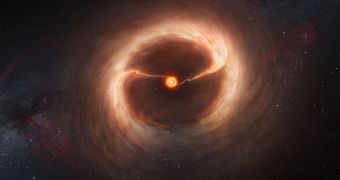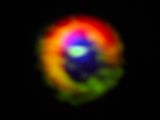ALMA, or the Atacama Large Millimeter/submillimeter Array, hasn't been completed yet, but it is already churning out some stunning images of the universe and providing valuable data into some never-before-seen phenomena.
The latest such spectacular image is a shot of gas giant planets forming around a young star, a first of its kind find.
This stage of planet formation has never been captured by a telescope, particularly because no telescope was capable of seeing with this great a detail before ALMA.
ALMA, radio telescope as its name suggests, was pointed at HD 142527, a nearby young star 450 light-years away from Earth.
The star hasn't even stopped growing, but planets are already forming around it. Astronomers had already observed the star and saw the large gas and disk cloud around it as well as a peculiar gap nearer to the star.
The gap had to have been created by another object or objects, a companion star or large planets.
While the planets themselves haven't been detected, there's too much gas and dust to be able to see them, the tell-tale signs of their existence have been seen by ALMA.
Using the radio telescope, astronomers were able to detect small filaments inside the gap around the star which were not seen by other telescopes.
Theory predicted that planets forming around stars would create these streams of gas and dust as they pulled material from the surrounding cloud.
The planets' gravity pulls gas from the cloud, but it also feeds the star itself as the gas, first attracted by the planets, gets near enough to the star to be influenced by its gravity.
This has enabled the star to continue to feed and grow even after it gobbled up all the gas it would normally pull by itself.
The star is some two million years old. At this stage, planetesimals, i.e. early planets still growing, should have formed. That's exactly what ALMA found, as it saw two streams from the outer gas cloud towards the star.
The find indicates that there are at least two planets in the gas cloud gap, which extends from a distance equal to Saturn's orbit to about 14 times that. ALMA also found that the central gap isn't completely empty, but is made up of diffuse CO gas, shown in blue in the second image.
With thousands of exoplanets discovered or awaiting confirmation, finding new planets isn't that exciting anymore.
The focus is now on finding specific types of planets, i.e. Earth equivalents, and discovering more about the planets we know about, beyond just the approximate mass and orbit.
Not all of the 66 antennas that make up ALMA are operational, so when the telescope is fully working, astronomers should be able to get an even clearer view of the star and its surroundings and even see the planets themselves, which they haven't been able to so far.

 14 DAY TRIAL //
14 DAY TRIAL // 
